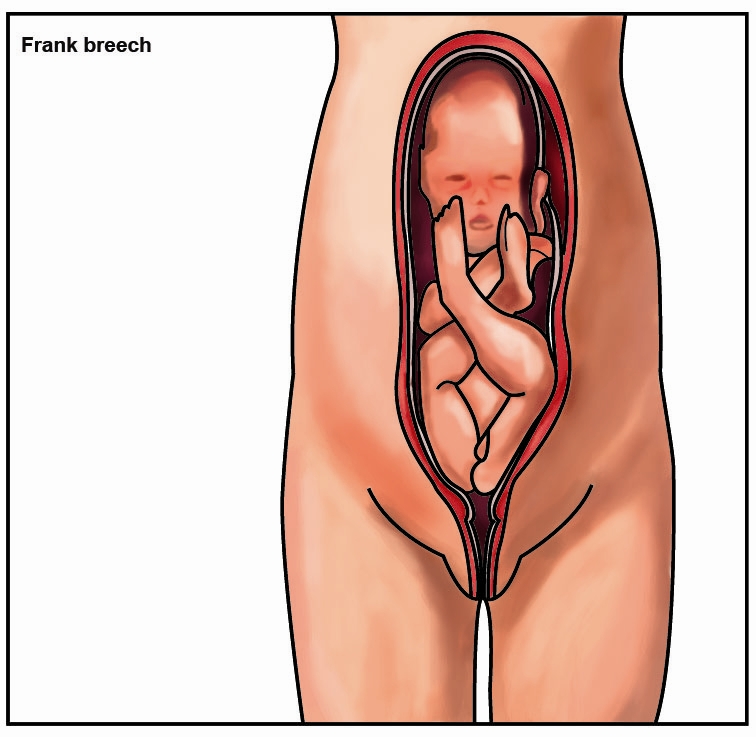
What is breech?
Breech means your baby is lying bottom first or feet first in the womb. Usually the head lies at the bottom of the womb. After 36 weeks, only about 3% of babies will be in a breech position.
What are the different types of breech?
- Extended (frank) breech
- Flexed breech
- Footling breech
What are the causes of breech?
Occasionally there is no cause for the breech. Possible causes for breech in which your doctor will try to exclude are:
- Prematurity i.e less than 37 completed weeks
- Too little or too much of amniotic fluid in the womb
- Abnormal shape of the womb
- Abnormal position of the placenta i.e Placenta previa
- Presence of fibroid or ovarian cysts
- In subsequent pregnancies. This is usually due to the lax muscles of the womb.
- Multiple pregnancy
- Abnormalities in the baby
How is a breech presentation diagnosed?
It could be diagnosed either by palpating the mother’s tummy, on vaginal examination or on ultrasound.
Should anything be done if my baby is breech?
This depends on how far along you are in your pregnancy. If you already 37 weeks, your doctor will examine you and do an ultrasound on you to find out whether there are any obvious causes that your baby is breech. Your doctor will then advise on the best way to deliver your baby. If you have not reach 37 weeks yet, then it is best to wait for your baby to spontaneous turn to head first position.
Is there anything else I could do if my baby is breech?
There may be several alternative treatments. These include:
- Webster technique. This is a technique performed by chiropractors in the 8thmonth of pregnancy to release stress on the pregnant woman’s pelvis causing relaxation of the womb and surrounding ligaments leading to your baby hopefully turning to head first position naturally.
- Breech Tilt: This natural treatment involves raising your hips 30cm off the floor using large, solid pillows about 3 times / day for 10 -15 minutes. Do this on an empty stomach.
- Traditional Chinese treatment : using moxibusti
However, there is no conclusive scientific evidence to show that the above treatment works. Talk to your doctor about it.
What are my choices of birth if my baby is breech?
Your obstetrician will offer you several choices of birth:
- External cephalic version. (ECV) This is a technique which applies gentle pressure on your abdomen to turn your baby to head first position.
- Caesarean section
- Vaginal breech delivery
Picture 2: Showing how an ECV is performed
Should I choose to have an ECV?
This needs to be discussed with your doctor. Provided you do not have any contraindications to having the ECV, the ECV is a good option to turn your baby into head first position. Read further on the topic ECV in order to decide to go ahead with the procedure or not.
Which options should I choose a vaginal breech delivery or caesarean section?
This again needs to be discussed carefully with your doctor. There are pros and cons for each option of delivery. The Royal College of Obstetricians and Gynaecologist (RCOG) and the National Institute for Health and Clinical Excellence (NICE) recommend that caesarean section is safer for the baby around the time of birth.
However, there are a few conditions where your doctor will advise you against having a vaginal breech delivery:
- Your baby is a footling breech as there is a higher risk the baby’s umbilical cord falling out causing a depletion in the baby’s oxygen supply
- Your baby’s estimated weight is more than 3.8kg
- Your baby’s estimated weight is less than 2kg
- Your baby’s neck is very tilted backwards (hyperextended)
- You have a very narrow pelvis
- You have other medical condtion such as pre-eclampsia
- You have other obstetric contraindications such as placenta previa
What happens in my future pregnancy if I have a caesarean section for breech?
Caesarean section has a slightly higher risk for you compared to vaginal breech delivery. However, provided there are no contraindications for a vaginal delivery in future, most women could safely attempt a vaginal delivery in their future pregnancy successfully.
RECOMMENDED BOOKS:
REFERENCE:
Patient information: A breech baby at the end of pregnancy. Royal College of Obstetricians and Gynaecologists, February 2008.
Filed under Obstetrics Conditions | No Comments

.jpg)







